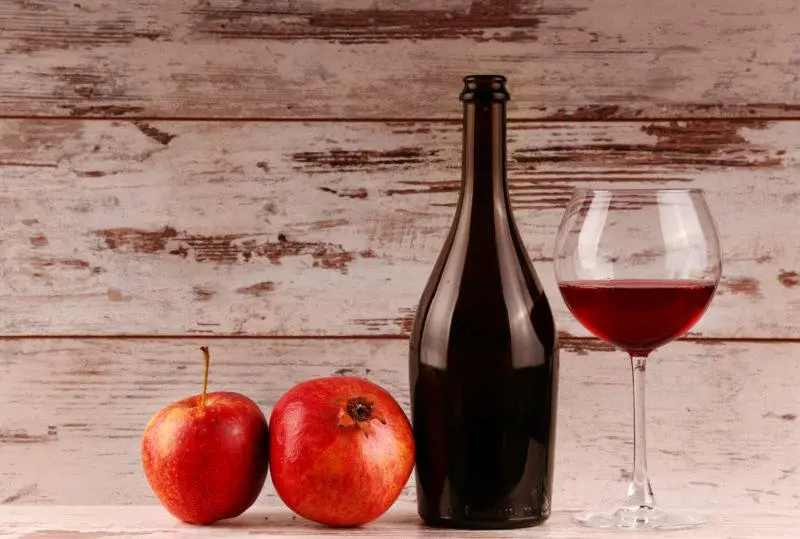Contents
No, well, “precious”, of course, in a figurative sense, if you do not take into account the price of pomegranates in those areas where they are not grown. However, this unfortunate fact has never stopped home alcoholic enthusiasts, especially since this common raw material can produce a real treasure, not only deliciously beautiful, but also amazingly tasty! So we are arming ourselves, like medieval alchemists, with flasks and retorts, and we will try to create a jewel with our own hands – the noblest wine from pomegranate!
Pomegranate is an amazing fruit! There is not enough sugar in it (although some varieties can contain up to 20% sugars), but there are a lot of acids (up to 9% in some varieties), a rich and rich taste – the juice will need to be diluted with water for normal fermentation, which means that we will get more product. Pomegranates also contain quite a lot of tannins and tannins, which will guarantee good storage of the drink and its resistance to diseases. There are many recipes for homemade pomegranate wines, today we will present you the most interesting and reliable of them – the simplest wine, consisting only of pomegranates, water and sugar, and two classic American recipes: one with raisins, lemons and oranges, and the second with such an unusual an additive, like … barley groats.

According to all three recipes, the wine is made for quite a long time – about a year. If you want to get a delicious drink faster, use one of the recipes for pomegranate tincture, the same article describes life hacks for separating pomegranate seeds from … hmm, chaff, they will help us in making wine. Many “experts” on the Internet advise adding acid mixtures and tannins to homemade pomegranate wine. As for me, this should not be done – there are plenty of these substances in the fruits themselves. Also, do not believe recipes that indicate too little water – for example, 50 grams per liter of juice, this is not enough, we do not have such sweet and low-acid varieties of pomegranates.
Pomegranate wine at home – the first recipe, basic
Simple and lethal, like RGD-5. It does not need anything, except, in fact, pomegranate fruits, sugar and water. According to the classics, such wine roams on wild yeast, but I would advise you to stock up on purchased wine just in case. Winter, after all, those “savages” who lived on fruits could have died from frostbite long ago, besides, we do not use the peel. Of course, you can try to make raisin sourdough (a good recipe is described here), but it’s better not to skimp on CKD – the wine will ferment faster and better on them, it will be stronger and more stable.

- ripe pomegranate – 5 kg
- water – 5 liters
- sugar – 1,2 kg
- yeast for red wines and top dressing – optional
In fact, the proportions are very conditional. All pomegranates are different, their sweetness and acidity is highly dependent on harvest time, storage conditions, temperature and a whole bunch of other factors. Therefore, it is best to rely not on the recipe, but on your own taste sensations. The must must be tasted, adjusting the taste with water and sugar. Too sour? We dilute. Little sweetness? Throwing sugar. It is most reliable to navigate by special winemaking instruments – a pH meter and a sugar meter, the optimal acidity is 0.7%, sugar content – 18-20%.

How to make homemade pomegranate wine? And just like any other berry or fruit wine!
- We clean the pomegranates, extracting the seeds. We put them in a suitable container, carefully crush them with a pusher. We add a little – a couple of liters – of water, half of the sugar, yeast and a nutrient mixture (or raisin sourdough).
- We are waiting for it to ferment and put it in a warm place under a water seal – right along with the bones. After a couple of days of active fermentation, when the pulp is already softened enough, the must must be drained, the pulp must be carefully squeezed out.
- We try the future wine and adjust the acid-sugar in the above way. These proportions, in principle, are universal and are suitable for pomegranate varieties common in the middle lane – that is, those that can be bought on the market, but it is better to focus on your own taste. When the acidity-sugar content of the liquid suits you, pour everything into a fermentation bottle.
- Active fermentation will continue for another 3-5 days (on wine yeast) or up to 40 days (on sourdough or savages). You can diagnose the end of fermentation by clarification of the wort, the precipitation of a dense sediment of yeast and pomegranate pulp residues at the bottom of the bottle, and also by the fact that the water seal has stopped gurgling.
- We decant the young wine through a straw, pour it into a smaller fermenter by 90-95% of the volume and rearrange it in a cool – 10-12 ° – place for fermentation. Secondary fermentation usually lasts 2-3 months, during which time the wort needs to be decanted 3-4 more times if sediment forms.
- After the wine has become absolutely transparent and the sediment no longer appears, you can bottle it. It is recommended to try not earlier than six months later.
In the same way, you can make wine from store-bought pomegranate juice – the recipe is universal. But here it all depends on what the manufacturer stuffed into their products, how much water and sugar it contains, and how much juice itself. If you are lucky enough to get pure juice, you can follow the indicated proportions, otherwise they need to be adjusted. In this case, we will definitely need CKD – raisin sourdough is not enough here, store-bought juice, processed with chemistry and pasteurized, is unlikely to ferment on wild yeast.
Barley pomegranate wine
A classic American recipe described by respected Texas vintner Jack Keller. Honestly, for the life of me I don’t understand why barley is here. But, apparently, it gives something – color, aroma, some substances necessary for the must, density … In general, you can experiment with American classics, or you can simply do without this ingredient and make ordinary pomegranate wine. Pomegranates for this recipe need sweet and not very sour – these are common in the USA.

- ripe pomegranates – 12-15 large
- barley groats – 225 g
- juice of one lemon
- sugar – 1,3 kg
- water – 4 liters
- yeast and top dressing – according to the instructions
Groats must first be boiled for 5-10 minutes, in half of all water. Peel the pomegranates, pour the grains with hot barley broth through a sieve so that grains do not get into the wine, add sugar and lemon juice, the rest of the water, mix everything well. When the mixture has cooled to room temperature, add yeast with top dressing. When signs of fermentation appear, pour the mixture into a bottle and put it under a water seal for 5-7 days. At the end of the primary fermentation, drain the wine, squeeze the pomegranate pulp well. Pour the drink into a smaller bottle almost to the top, put it under the shutter again and transfer it to a cool place for another couple of months. During this time, the wine must be drained several times from the sediment. If it no longer forms, then it is ready, the wine can be poured into bottles for aging. The organoleptic properties of the drink will improve throughout the year with proper storage, so it’s best not to drink it all at once.
By the way, do-it-yourself pomegranate wine is not only a tasty and fragrant booze, but also a folk remedy! This drink contains a lot of useful things – and linoleic acid, which can normalize lipid metabolism, neutralize carcinogens, increase immunity, and antioxidants (more than in red grape wine) that slow down aging, and vitamins C, P, B6, B12, and antiviral tannin . Such a drug strengthens the walls of blood vessels, has a beneficial effect on the nervous system (of course!), Cleanses the body of toxins. But, of course, the benefits and harms of pomegranate wine directly depend on the amount consumed – if you lap it with cans, nothing good will come of it.
Homemade pomegranate wine with orange, raisins and lemon
Also an American recipe, authorship belongs to Dana Grit, a well-known blogger and winemaker. It is not difficult to prepare such a wine, the ingredients, in general, are quite accessible, and it should turn out delicious, since the rather monotonous taste of pomegranate here will be shaded by citrus fruits, and raisins will give the drink a “body” – additional density, strength and deep nutty aroma.

- 20 large ripe pomegranates
- 1 kg raisins (or 0,5 kg raisins and 0,5 kg dried black currants)
- 4 orange
- 4 lemons peel
- sugar – 2,5 kg
- water – 7,5 l
- wine yeast and dressing for 15 liters of must
The recipe is almost the same as the last two. Peel the pomegranates, mash them, add water, add raisins, sugar, thinly cut the zest from oranges and lemons, add to the must, squeeze the juice from the oranges as well. Introduce yeast along with top dressing. When fermentation begins, pour the wort into a suitable vessel, put a water seal and transfer to a warm place. When the fermentation is over – drain the liquid, squeeze the pulp thoroughly. Pour everything into a smaller bottle, set aside in a cool place for a couple of months, decant periodically. After clarification – pour into bottles. It will be possible to uncork the first one in six months.

How to make homemade wine from pomegranate, it seems, is understandable. And how and with what do they drink pomegranate wine? This is a rather viscous and dense drink, more tart and full-bodied than red grape wine. Tasters distinguish bright nutty notes, shades of cherry and tobacco in the aftertaste. Dry varieties are great as an aperitif, sweet varieties go well with desserts, especially fruit ones, as well as with a cigar or pipe. Such a drink is served slightly chilled – up to 14-15 degrees. And do not forget to enjoy the color of the wine in the glass before tasting – if everything is done correctly, it will be surprisingly beautiful, pomegranate-colored with a noble golden tint. I say treasure!









